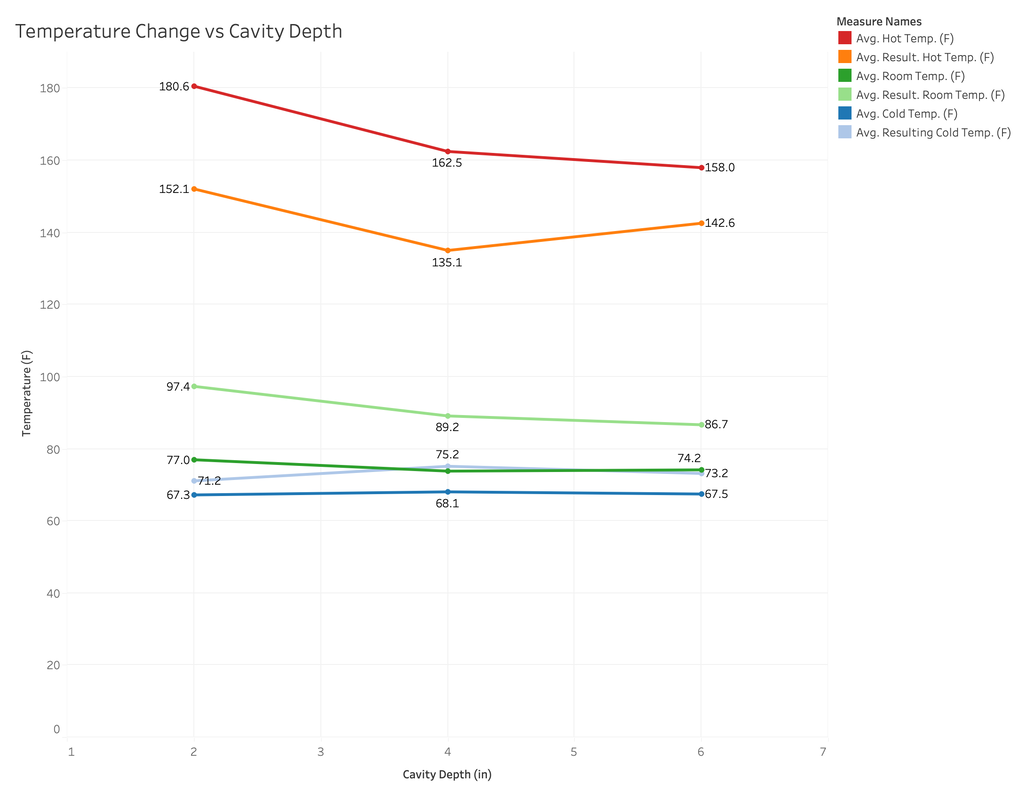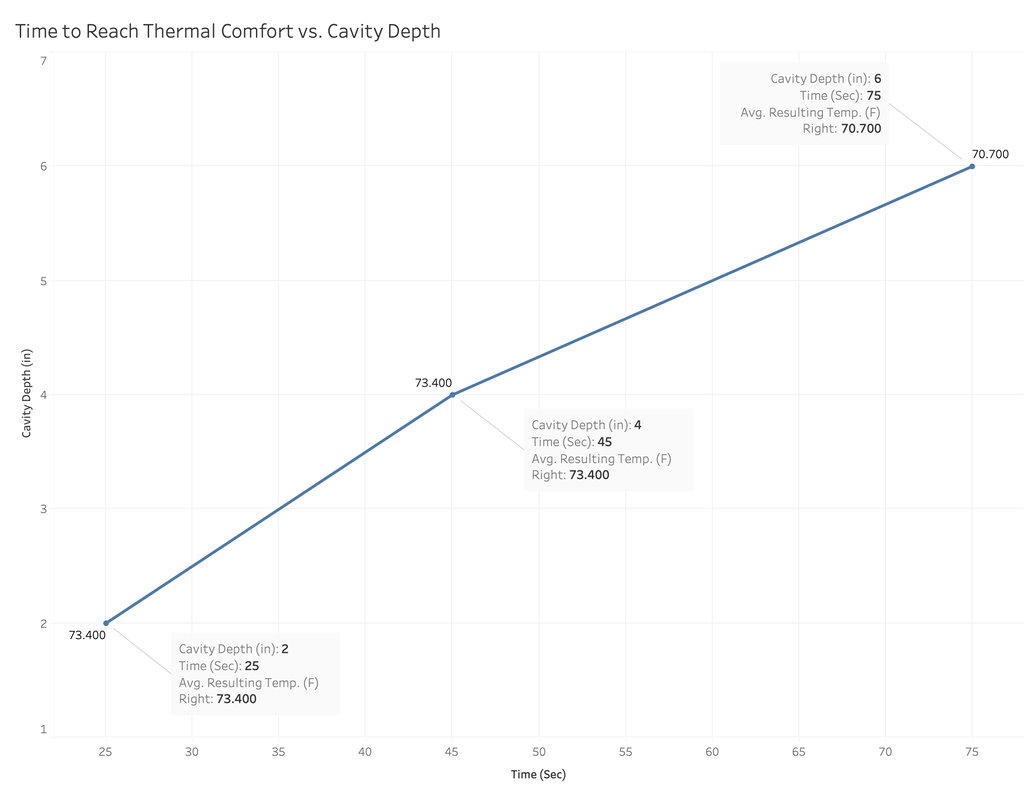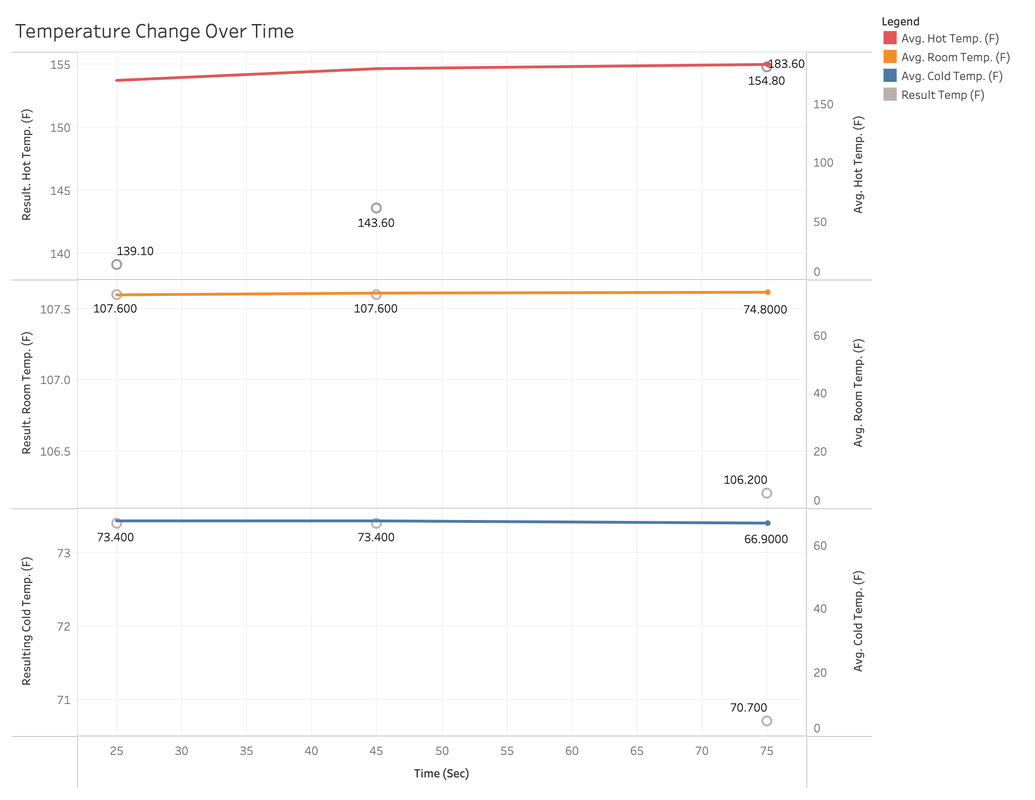Results
Test A: Solid + Solid Sheets:
Analyzing the air flow within the central cavity and temperature variation in each chamber
Cavity Depth (in) |
Left Chamber (Hot Temp.) (F) |
Cavity (Room Temp.) (F) |
Right Chamber (Cold Temp.) (F) |
2 |
Initial: 180 Resulting: 148.1 |
Initial: 80 Resulting: 97 |
Initial: 67.5 Resulting: 68.9 |
2 (Second Attempt) |
Initial: 181.2 Resulting: 156.2 |
Initial: 74 Resulting: 97.7 |
Initial: 67 Resulting: 73.4 |
4 |
Initial: 160 Resulting: 143.6 |
Initial: 73.6 Resulting: 90.5 |
Initial: 68.2 Resulting: 77 |
4 (Second Attempt) |
Initial: 165 Resulting: 126.5 |
Initial: 74.1 Resulting: 87.8 |
Initial: 68 Resulting: 73.4 |
6 |
Initial: 158.4 Resulting: 140.2 |
Initial: 74.5 Resulting: 87.3 |
Initial: 67.5 Resulting: 74.8 |
6 (Second Attempt) |
Initial: 157.6 Resulting: 145 |
Initial: 73.9 Resulting: 86.2 |
Initial: 67.5 Resulting: 71.6 |
Test B: Solid + Perforated Sheets:
Measuring air flow to cavity and time taken to reach desired thermal comfort in an interior space
Cavity Depth (in) |
Left Chamber (Hot Temp.) (F) |
Cavity (Room Temp.) (F) |
Right Chamber (Cold Temp.) (F) |
Time (Sec) |
Desired Thermal Comfort Temp. (Indoor) (F) |
2 |
Initial: 170 Resulting: 139.1 |
Initial: 73.9 Resulting: 107.6 |
Initial: 67.6 Resulting: 73.4 |
25 |
68-74 (Winter) 72-80 (Summer) |
4 |
Initial: 180 Resulting: 143.6 |
Initial: 74.5 Resulting: 107.6 |
Initial: 67.6 Resulting: 73.4 |
45 |
68-74 (Winter) 72-80 (Summer) |
6 |
Initial: 183.6 Resulting: 154.8 |
Initial: 74.8 Resulting: 106.2 |
Initial: 66.9 Resulting: 70.7 |
75 |
68-74 (Winter) 72-80 (Summer) |
Conclusion
Due to the nature of the test and even with the extensive exploration into creating a watertight seal between chambers there was still some leakage creating a small margin of error. Therefore, it seems like the smallest cavity depth (2”) performed better than the largest cavity depth (6”) in both Test A and Test B.
In Test A, the 2” cavity depth had more of a visual difference in the movement of the ink in the cavity but also the temperature of the cold water had a greater increase than the 6” cavity depth. The temperature of the cold water with the 2” cavity increased from 67 degrees to 73 degrees while the 6” cavity only increased from 67.5 degrees to 71.5 degrees. The ink when dropped into the 2” cavity can be seen moving immediately towards the hot water while the ink dropped into the 6” cavity almost immediately disperses in the water.
In Test B, the cold water temperature increases at a much faster rate in the 2” cavity than the 6” cavity. In the 2” cavity the cold water temperature rises from 67.6 degrees to 73.4 in 25 seconds while the cold water in the 6” cavity rises from 66.9 degrees to 73.4 in 45 seconds.
In Test A, the 2” cavity depth had more of a visual difference in the movement of the ink in the cavity but also the temperature of the cold water had a greater increase than the 6” cavity depth. The temperature of the cold water with the 2” cavity increased from 67 degrees to 73 degrees while the 6” cavity only increased from 67.5 degrees to 71.5 degrees. The ink when dropped into the 2” cavity can be seen moving immediately towards the hot water while the ink dropped into the 6” cavity almost immediately disperses in the water.
In Test B, the cold water temperature increases at a much faster rate in the 2” cavity than the 6” cavity. In the 2” cavity the cold water temperature rises from 67.6 degrees to 73.4 in 25 seconds while the cold water in the 6” cavity rises from 66.9 degrees to 73.4 in 45 seconds.


